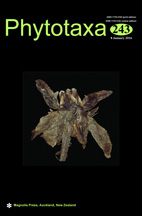Abstract
A summary of the Neotropical exindusiate species of Cyathea with bipinnate-pinnatifid or more complex fronds is presented. It is a polyphyletic group containing species of the obsolete genera Trichipteris and Sphaeropteris subg. Sclephropteris with several unresolved species complexes, like Cyathea lasiosora and C. pilosissima from the eastern Andean foothills and the Amazonian lowland. This study shows that their confusion is mainly due to intraspecific variability in the abundance of laminar hairs in C. lasiosora, which overlaps with that of C. pilosissima, and that the latter species is less frequently collected than the former. With sufficient material at hand, both stand clearly apart in petiolar characters, e.g., C. lasiosora lacking hairs here vs. C. pilosissima with hairs 1–3 mm long. A close relationship of C. pilosissima with species of the obsolete, artificial Sphaeropteris senilis group (C. senilis, C. parianensis, C. lockwoodiana) is discussed. Cyathea lasiosora (Amazon basin) forms a parapatric species complex with C. wendlandii (Central America and Chocó), C. schlimii (northern Andes) and C. atrocastanea (eastern Brazil). A taxon that shares the petiole morphology with C. lasiosora and the laminar morphology with C. lockwoodiana is separated as a new species: Cyathea calamitatis. Further described are C. diabolica from southern Ecuador and C. margarita from western Colombia and Ecuador.

